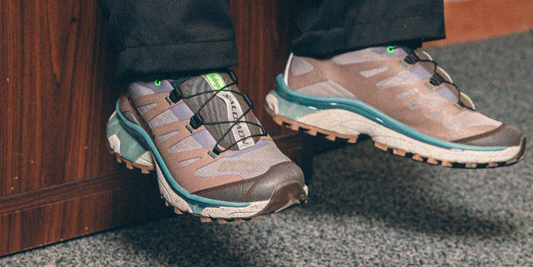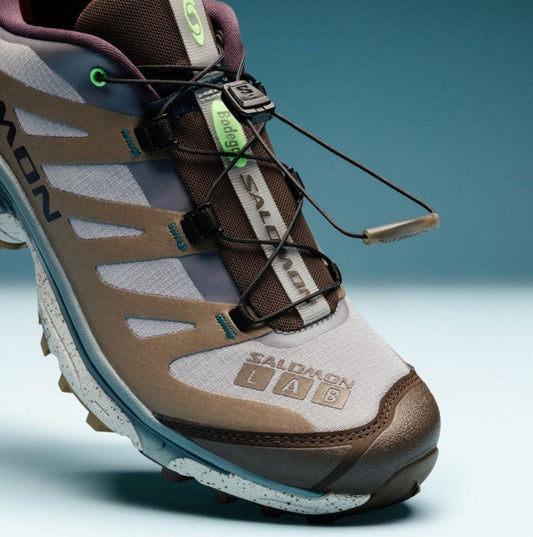Bodega presents "High Stakes" Capsule
In the literal, gambling sense, high stakes is a term connected to a tangible dollar amount. In Las Vegas for example, a minimum bet on a high roller table would be around $150,000. Six figures, on one roll of the dice, or bounce of a ball, or draw of a card, you get the idea. It isn’t an activity that just anyone can insert themselves into. Even if someone were to have the newly minted financial means to partake, that person would still have to steel themselves to the insane amount of risk involved.
In a colloquial sense though, high stakes doesn’t have to involve money. You could say that an activity involving a serious level of commitment and risk is high stakes. Only, a lot of activities that would qualify as high stakes aren’t necessarily afforded that level of respect. The average person may not have the means to wager six figures on the spin of a roulette wheel. The average person may even freely admit that they wouldn’t have the stomach for it, even if they did have the money, but the average person can understand why someone would take that risk. In the absence of potential financial reward, assuming a high level of risk is considered a cocktail of crazy and stupid.
The epithets ‘crazy’ and ‘stupid’ are intimately familiar to the proponents of action sports like skateboarding and BMX. Despite the level of commitment and skill required by these activities, the stereotypical view of action sports is intertwined with condensation about slackers and shiftless millennials. Luckily, since establishment approval is a hindrance to any aspiring subculture, these views, however misguided, haven’t slowed down the world’s skaters and bikers. You could actually say that the risks involved make action sports an almost mythological creature, high stakes DIY.
Here’s the thing about DIY: although, in the modern usage, it is often used to mean something that is intentionally obscure, inaccessible and arty, DIY is meant to be taken much more literally. While one of the DIY level action sports, skateboarding, would break out to become a cornerstone of global youth culture, the other, BMX, would never really transcend its status as a sport. Even though BMX has the same thrill seeking, countercultural edge as skateboarding, it has higher barriers to entry, a situation which has helped to inoculate it against the superficial appropriation that has pushed actual skateboarding down the list of skate culture priorities. For one thing, owning and casually but conveniently conspicuously displaying a BMX bike that is rarely, or never, used is far more expensive, and takes up more space than a just for show skateboard. Perhaps more importantly, while it may be feasible to fake your way through the bare bones of riding a skateboard, the bare bones of BMX are “riding a bike.” Possession of a BMX bike inherently suggests some level of aptitude at the necessary skills. Trying to fake your way through those is a greater physical risk. So, even after all these years, BMX remains an interest that primarily exists for the sole benefit of people who actively participate in it.
You won’t exactly find a lot of BMX riders losing sleep at night that it isn’t easier to pretend to be one of them, but owing to the somewhat lower profile, the history of BMX is, if not one of the great forgotten DIY stories, definitely one of the great, underappreciated ones.
What made the rise of BMX especially groundbreaking was that its early participants simply willed it into existence out of nothing. The MX in BMX refers to motocross, a form of off-road motorcycle racing. In the early 70s, motocross’s profile was raised by stadium events, including an influential one in the Los Angeles Coliseum, and a documentary movie, On Any Sunday. Suitably inspired, but with access to actual motorcycles blocked off by age restriction and finances, many Southern California kids simply began to emulate motocross as best they could, using their bicycles. At first, standard road bikes were simply modified for off-road conditions, but the movement became popular enough for bike manufacturers to take notice, and design specifically for the needs of this new sport. Bicycle Motocross, or BMX, was born, and would later evolve into a multidisciplinary field that reflected the wildly individualistic nature of its participants, with everything from off-road racing to skateboard style vertical ramp riding represented. This is the true, independent spirited essence of DIY. A bunch of kids wanted to do something that didn’t technically exist yet, so they created it.
Vans, as a company, have a longstanding, close association with action sports subcultures that have cemented the brand’s legacy as alternative, DIY legends. It’s a story that has been told countless times, and you certainly don’t need us to state the obvious, or including the millionth picture of Jeff Spicoli wielding a checkerboard slip on to be convinced.
In 1966, when Vans opened their doors for the first time in Anaheim California, they certainly didn’t have a premeditated plan to become the alternative brand, or the action sports brand. They were making the best shoes that they could, within the confines of their material constraints. They didn’t have the high-tech set ups of athletic footwear giants, but they did have a vulcanized rubber sole with armored vehicle like durability, and a willingness to individually customize designs to their customers’ liking. It just so happened that burgeoning action sports, the ground zero for which took place in Southern California, prized both individualism and reliably durable footwear. Although this affinity wasn’t planned, when it became apparent, it was cultivated, as Vans began to design shoes with the specific demands of these sports in mind. The rest is history.
Vault by Vans and Bodega tap into the individualistic streak behind customized Vans uppers and modified bikes, with a new, collaborative pack, as two Vans icons, the Slip On and Sk8-Hi are outfitted with an all-over dice print pattern. The Bodega x Vault by Vans High Stakes pack celebrates the element of risk that comes with every roll of the dice, and the nerve to face down a sport where you put intact body parts, and not gambling chips on the table, a sport the cruel indifference of gravity measures winning and losing in terms of spectacular landings and painful physics lessons.
The Sk8-Hi emphasizes the BMX connection by rendering its signature side stripe as a bicycle chain. Besides dice being an eternally popular motif for pretty much any mode of wheeled transport, dice valve caps were an especially popular accessory amongst youth and adults alike, even to the point of “acquiring” them off of parked cars, which is actually another form of risk. The accompanying Bodega High Stakes capsule consists of apparel that doesn’t just look the “alternative” part, but is meant to stand up to the beating dished out by all those instances when the dice don’t roll your way.
Ultimately, the Bodega x Vault by Vans High Stakes pack and the Bodega High Stakes capsule, like BMX itself, aren’t sweating whether or not they tick all the algorithmic marketing boxes. They’re there for people who want to wear this stuff because they actually like it. Pretenders, please step aside.
Release Info: Saturday, December 14, 2019
Available online and in-store at our Boston location at 10am EST,
and in-store at our Los Angeles location at 11am PST,
on a first come, first served basis.







